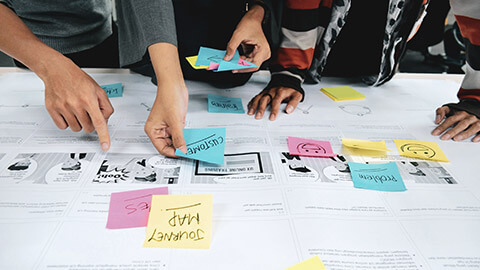In this topic we will cover the following:
- Getting to know yourself
- Managing expectations when working in a team
- Working with UI/UX project stakeholders.
The topic includes an opportunity to discover more about yourself and how you work in a team with a personality test.
If you want to go fast, go alone. If you want to go far, go together.
African Proverb
Can you recall a time when you had to work in a team?
Is there more than one instance you can remember?
It does not matter how big or small the project was. You were part of a team's effort. These efforts will have different outcomes. They do not always turn out the way you have planned, or they might have turned out better than expected. We will look at how gaining insights into yourself and managing expectations when working with others will play a role in successful project management.

Knowing others is wisdom. Knowing yourself is enlightenment.
Lao Tzu, Ancient Chinese Quote
Understanding who you are as a person will empower you to grow in your personal and professional life. It will also improve the relationships with yourself and those around you. As the quote says above, knowing yourself is enlightenment.
You have been living with yourself for the longest possible time, but this does not grant the knowledge of knowing yourself. It takes time, openness, honesty, and a willingness to learn. After all, who is better to unfold the origami of who you are but yourself.
The following five minute video from The School of Life introduces us to the concept of knowing ourselves intellectually vs knowing ourselves emotionally.
Personality test
There are many schools and thought leaders on personality models.
According to Truity Psychometrics, a developer and publisher of online personality and career tests, OCEAN or CANOE ‘Big 5 Personality Test’ is an acronym derived from the qualities of
- Openness - a person's tendency to think abstractly
- Conscientiousness - a person's level of goal orientation and persistence
- Extraversion - a person’s inclination to seek stimulation from the outside world, especially in the form of attention from other people.
- Agreeableness - the extent to which a person prioritises the needs of others over their own needs.
- Neuroticism - a person's tendency to respond to stressors with negative emotions, including fear, sadness, anxiety, guilt, and shame.
Individuals can be described as having high, average, or low levels of the five personality factors. Each factor stands alone from the others, so a person might be high in Introversion and low in Agreeableness. To paint a full picture of an individual using the Big Five model, it is helpful to see how five dimensions relate to each other.
Personality tests are a great way to draw a deeper understanding of yourself. This includes information about how you communicate, your friendships, your work life and your relationships.
Your task is to complete the test, and base your answers on your natural, core self.

Depending on your past experiences, you might loathe, love, or be indifferent towards working in a team.
The key to navigating the different dynamics of teamwork is knowing yourself and managing your expectations of others. This approach will be beneficial for every participant in the team.
Psychologist Bruce Tuckman developed a theory that helps define the dynamics of a team's performance. It is described as the 'norming, storming, forming, performing' lifecycle. This theory was developed as part of his 1965 paper "Developmental Sequence in Small Groups” which is still used and relevant today. These stages describe a natural and common flow that teams often encounter when assigned to new projects.
The 'norming, storming, forming, performing' lifecycle
Norming
It is the beginning of a new project. Team members learn about the team's goals and objectives. Norms are set and this will include habits, customs, and expectations.
Storming
Team members have had the chance to work with each other for some time. They have encountered different challenges. Disagreements, personality clashes, and misunderstandings might occur. Team members learn to overcome these challenges. They might experience setbacks or move forward.
Forming
Team members have a better understanding of each other's strengths and weaknesses. They can see past their differences. Norms for this group setting is adjusted and solidified.
Performing
Team members have excelled at working with each other. Respect, trust, authority, and autonomy are given amongst each other. The team performs well and is achieving its goals and objectives.

Every project has pre-existing constraints and requirements, whether you are an internal designer working for a small company or an external designer working for a large company, and everything in-between.
You are working with “clients” who have stakes in the successful outcomes of the project. These clients are part of your stakeholder groups.
Stakeholders of a UI/UX project
| Business/Client Side | UX Design | Technical Side |
|---|---|---|
|
|
|
A Business Analyst’s role is to perform business analysis (a process to identify complex processes and break them into individual steps).
A Project Manager's role is to oversee the overall process of the project.
Subject Matter Experts can include a Product Manager, Accounts or Legal team, anyone in the business with a specific subject knowledge.
As a designer or UX person you are likely to spend a significant amount of time with business analysts (BA) and project managers (PM). Relationship building is especially crucial at the beginning when collecting the facts and gathering requirements. As a designer in smaller projects or companies, you can find yourself dealing with both of these stakeholders or taking on their tasks.
Another important part of your role is to call out assumptions and keep your eyes open for things that the BA or PM has missed. Always keep the user in mind. It is easy to forget about the user when all the business stakeholders overwhelm you with their needs and goals.
Challenges you might face when working with BAs and PMs
- Prioritisation
- Collecting the facts
- Gathering requirements
- Budget versus business needs
- Budget versus timeframe.
Common pitfalls when working with BAs and PMs
- Product solution is business-focused instead of user-focused
- Users' needs are not driving the project
- Confronting existing muddled or cluttered sites
- Missed opportunities for business when issues are not addressed
- Plenty of elements competing for attention; no clear purpose
- Difficult to diagnose because it feels like "everything's in there that we wanted"
- The application prioritises activities that are not directly tied to the business objectives.
Advantages of working with BAs and PMs
- See the big picture
- Bring generic skills to a variety of similar situations
- Communicate between technical and non-technical (business) people
- Provide continuity from conception to completion
- Responsible for the overall quality of the things produced.
Before you hit that roadblock…
- Be proactive. Seeking assistance from your teammates shows initiative.
- Check your milestones. Tick off the small actionable steps that lead to your main goal.
- Visualise your road map. Use the timeline to keep track of project progress.
- Feeling stuck? Talk it out. Communicate both your progress and hurdles at status meetings.
- Need a break? That is okay. Do not go Missing in Action and ignore your messages, emails, and calls. If you know you are going to be away or are sick, let your team know.
Understanding who you are as a person will empower you to grow in your personal and professional life. The key to navigating the different dynamics of teamwork is knowing yourself and managing your expectations of others.
The dynamics of a team's performance can be summarised into the four stages of norming, storming, forming, and performing based on the theory by Psychologist Bruce Tuckman.
Besides the immediate UI/UX team, you will be working with other stakeholders from the business or client side, and the technical side.
It is important to maintain the line of communication with your team and identify key support people you can go to for help.
Check your knowledge of working in a team by answering the following questions.
Additional resources
Here are some links to help you learn more about this topic.
It is expected that you should complete 12 hours (FT) or 6 hours (PT) of student-directed learning each week. These resources will make up part of your own student-directed learning hours.

